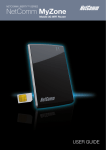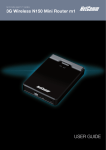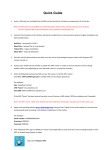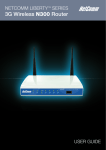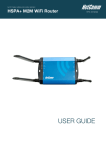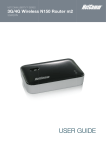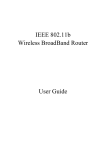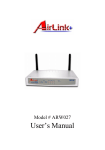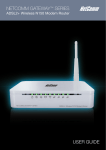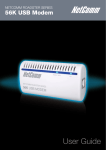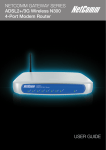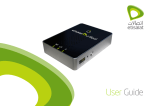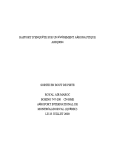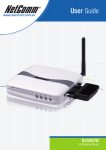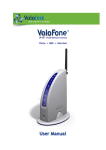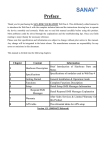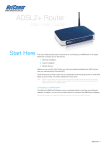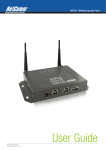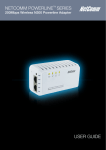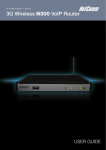Download NETCOMM LIBERTY™ SERIES USER GUIDE
Transcript
NETCOMM LIBERTY™ SERIES 3G Travel Router t1 USER GUIDE Preface This manual provides information related to the installation, operation, and application of this device. The individual reading this manual is presumed to have a basic understanding of telecommunications terminology and concepts. If you find the product to be broken or malfunctioning, please contact technical support for immediate service by email at [email protected] For product update, new product release, manual revision, or software upgrades, please visit our website at www.netcommlimited.com Important Safety Instructions With reference to unpacking, installation, use and maintenance of your electronic device, the following basic guidelines are recommended: • Do not use or install this product near water, to avoid fire or shock hazard. For example, near a bathtub, kitchen sink or laundry tub, or near a swimming pool. Also, do not expose the equipment to rain or damp areas (e.g. a wet basement). • Do not connect the power supply cord on elevated surfaces. Allow it to lie freely. There should be no obstructions in its path and no heavy items should be placed on the cord. In addition, do not walk on, step on or mistreat the cord. • Use only the power cord and adapter that are shipped with this device. • To safeguard the equipment against overheating, make sure that all openings in the unit that offer exposure to air are not blocked. • Avoid using a telephone (other than a cordless type) during an electrical storm. There may be a remote risk of electric shock from lightening. Also, do not use the telephone to report a gas leak in the vicinity of the leak. • Never install telephone wiring during stormy weather conditions. WARNING • Disconnect the power line from the device before servicing. Copyright Copyright©2009 NetComm Limited. All rights reserved. The information contained herein is proprietary to NetComm Limited. No part of this document may be translated, transcribed, reproduced, in any form, or by any means without prior written consent of NetComm Limited NOTE:This document is subject to change without notice. Save Our Environment When this equipment has reached the end of its useful life, it must be taken to a recycling centre and processed separate from domestic waste. The cardboard box, the plastic contained in the packaging, and the parts that make up this router can be recycled in accordance with regionally established regulations. Never dispose of this electronic equipment along with your household waste. You may be subject to penalties or sanctions under the law. Instead, ask for disposal instructions from your municipal government. Please be responsible and protect our environment. 3G Travel Router t1 User Guide 2 YMLT1WN www.netcomm.com.au NetComm Liberty Series - 3G Travel Router t1 Table of Contents Introduction................................................................................................................................................................................................5 Package Contents............................................................................................................................................................................................................5 Key Features.....................................................................................................................................................................................................................5 Placement���������������������������������������������������������������������������������������������������������������������������������������������������������������������������������������������������9 Getting Started�����������������������������������������������������������������������������������������������������������������������������������������������������������������������������������������11 The LED Indicators of the 3G Travel Router t1�����������������������������������������������������������������������������������������������������������������������������������������������������������������11 The Connectors and Buttons of the 3G Travel Router t1�������������������������������������������������������������������������������������������������������������������������������������������������11 Network and System Requirements��������������������������������������������������������������������������������������������������������������������������������������������������������������������������������12 Modem Requirements�����������������������������������������������������������������������������������������������������������������������������������������������������������������������������������������������������12 Configuring your Router and setting up your computer���������������������������������������������������������������������������������������������������������������������������������������������������14 Setting up your 3G Travel Router t1���������������������������������������������������������������������������������������������������������������������������������������������������������������������������������15 Advanced Features����������������������������������������������������������������������������������������������������������������������������������������������������������������������������������18 Login Procedure��������������������������������������������������������������������������������������������������������������������������������������������������������������������������������������������������������������18 Status�����������������������������������������������������������������������������������������������������������������������������������������������������������������������������������������������������������������������������18 Internet Settings �������������������������������������������������������������������������������������������������������������������������������������������������������������������������������������������������������������19 Advanced Routing�����������������������������������������������������������������������������������������������������������������������������������������������������������������������������������������������������������23 DHCP Client��������������������������������������������������������������������������������������������������������������������������������������������������������������������������������������������������������������������23 Basic�������������������������������������������������������������������������������������������������������������������������������������������������������������������������������������������������������������������������������25 Security���������������������������������������������������������������������������������������������������������������������������������������������������������������������������������������������������������������������������27 WPS�������������������������������������������������������������������������������������������������������������������������������������������������������������������������������������������������������������������������������29 Station List����������������������������������������������������������������������������������������������������������������������������������������������������������������������������������������������������������������������29 Firewall������������������������������������������������������������������������������������������������������������������������������������������������������������������������������������������������������31 MAC/IP/Port Filtering������������������������������������������������������������������������������������������������������������������������������������������������������������������������������������������������������31 System Security��������������������������������������������������������������������������������������������������������������������������������������������������������������������������������������������������������������32 Content Filtering��������������������������������������������������������������������������������������������������������������������������������������������������������������������������������������������������������������32 Port Forwarding��������������������������������������������������������������������������������������������������������������������������������������������������������������������������������������������������������������33 DMZ��������������������������������������������������������������������������������������������������������������������������������������������������������������������������������������������������������������������������������33 Administration������������������������������������������������������������������������������������������������������������������������������������������������������������������������������������������35 Upload Firmware�������������������������������������������������������������������������������������������������������������������������������������������������������������������������������������������������������������35 Setting Manager��������������������������������������������������������������������������������������������������������������������������������������������������������������������������������������������������������������36 Statistics�������������������������������������������������������������������������������������������������������������������������������������������������������������������������������������������������������������������������36 System Log���������������������������������������������������������������������������������������������������������������������������������������������������������������������������������������������������������������������36 Troubleshooting����������������������������������������������������������������������������������������������������������������������������������������������������������������������������������������38 Establishing your Wireless Connection���������������������������������������������������������������������������������������������������������������������������������������������������41 Windows XP service pack 2��������������������������������������������������������������������������������������������������������������������������������������������������������������������������������������������41 Mac OSX 10.4����������������������������������������������������������������������������������������������������������������������������������������������������������������������������������������������������������������43 Windows Vista����������������������������������������������������������������������������������������������������������������������������������������������������������������������������������������������������������������44 How to configure WEP/WPA-PSK/WPA2-PSK Wireless Security�������������������������������������������������������������������������������������������������������������������������������������45 Legal & Regulatory Information���������������������������������������������������������������������������������������������������������������������������������������������������������������48 Customer Information������������������������������������������������������������������������������������������������������������������������������������������������������������������������������������������������������48 Federal Communication Commission Interference Statement������������������������������������������������������������������������������������������������������������������������������������������49 Product Warranty������������������������������������������������������������������������������������������������������������������������������������������������������������������������������������������������������������49 Limitations of Warranty����������������������������������������������������������������������������������������������������������������������������������������������������������������������������������������������������50 www.netcomm.com.au/support��������������������������������������������������������������������������������������������������������������������������������������������������������������������������������������51 YMLT1WN www.netcomm.com.au 3G Travel Router t1 User Guide 3 INTRODUCTION NetComm Liberty Series - 3G Travel Router t1 Your 3G Travel Router t1 Congratulations on the purchase of your NetComm 3G Travel Router t1. NetComm’s 3G Travel Router t1 is a versatile and portable solution for wireless mobile broadband for the home, office or on the road. This device creates an instant Wireless N hotspot allowing you to share an Internet connection across multiple devices like smart phones, gaming consoles or other computers. With wireless data speeds of up to 150Mbps it is 300% faster than Wireless G technology1. Connection to the Internet is achieved through either a 3G USB modem or via a fixed line (DSL/Cable/Satellite) connection to the routers WAN port. The integrated Lithium-Ion battery delivers networking power for up to 5 hours in one power-charge-cycle, which means you can set up your own Wireless network without searching for a power point. Featuring automatic Internet failover, this device will keep you connected. In case the DSL/Cable/Satellite connection drops out, it activates the 3G connection. The WAN port can also be configured optionally as a LAN port for a wired connection to a network client. The device also features advanced security such as VPN pass-through, a full complement of wireless security options and a built in firewall. The setup is simple via NetComm’s browser interface. The firmware can be updated via NetComm’s website to take advantage of upcoming features. The NetComm 3G Travel Router t1 supports an extensive range of 3G USB modems from most major 3G carriers and is compatible with Mac OS X, Windows OS and Linux. For more information see www.netcomm.com.au for compatibility list. YMLT1WN www.netcomm.com.au 3G Travel Router t1 User Guide 5 Cordless Phones If the performance of your wireless network is impaired after considering the above issues, and you have a cordless phone: • Try moving cordless phones away from your Router and your wireless-enabled computers. • Unplug and remove the battery from any cordless phone that operates on the 2.4GHz band (check manufacturer’s information). If this fixes the problem, your phone may be interfering with the Wi-Fi Router. • If your phone supports channel selection, change the channel on the phone to the farthest channel from your wireless network. For example, change the phone to channel 1 and move your Router to channel 11. See your phones user manual for detailed instructions. • If necessary, consider switching to a 900MHz or 5GHz cordless phone. Choose the “Quietest” Channel for your Wireless Network In locations where homes or offices are close together, such as apartment buildings or office complexes, there may be wireless networks nearby that can conflict with your wireless network. Use the Site Survey capabilities found in the Wireless Utility of your wireless adapter to locate any other wireless networks that are available (see your wireless adapter’s user manual), and switch your Router and computers to a channel as far away from other networks as possible. • Experiment with more than one of the available channels, in order to find the clearest connection and avoid interference from neighbouring cordless phones or other wireless devices. • For NetComm wireless networking products, use the detailed Site Survey and wireless channel information included with your wireless network card. See your network card’s user guide for more information. These guidelines should allow you to cover the maximum possible area with your Router. Should you need to cover an even wider area, you should consider looking at building a hybrid network by combining your wireless network with a HomePlug Network. See the NetComm website for more details on Ethernet-Over-Power HomePlug products. 3G Travel Router t1 User Guide 6 YMLT1WN www.netcomm.com.au NetComm Liberty Series - 3G Travel Router t1 Package Contents 1. NetComm 3G Travel Router t1 2. 5VDC~2A Power Adapter 3. Ethernet CAT5E Crossover Cable 4. Quick Install Guide 5. CD-ROM (User’s Manual) 6. Li-lon Battery Key Features • Stylish and compact 3G Travel Router with internal Wi-Fi antenna and battery • Creates instant Wireless hotspots to share the Internet connection of a 3G USB modem or DSL/Cable modem • Supports Wireless N standard with data speeds up to 150Mbps1 • 1 USB 2.0 host port supports 3G modems, external storage and printers • Compatible with all 3G/Next G TM/UMTS/ HSPDA/ EV-DO/ USB modems from leading vendors • 1 WAN port for alternate wired Internet connection (DSL/Cable/Satellite via Ethernet) • Ensures connectivity and business continuity with auto-Internet-failover from WAN port to 3G USB modem • Mains-operated or up to 5 hours battery power if no power point is available • Hassle-free internal Wi-Fi antenna (1Transmit/1Receive) • Easy Wireless Protected Setup (WPS) by the single touch of a button to establish a secure wireless connection • Full Wireless security - WEP, WPA, WPA2 • Browser based interface for configuration and management: OS independent and easy to use YMLT1WN www.netcomm.com.au 3G Travel Router t1 User Guide 7 PLACEMENT OF YOUR T1 NetComm Liberty Series - 3G Travel Router t1 Placement Just like your mobile phone, a 3G USB Modem’s location will affect its signal strength to the 3G Mobile Base Station (Cell Tower). The data speed achievable from a 3G USB modem is relative to this signal strength, which is affected by many environmental factors. Please keep in mind that the 3G USB Modem will need adequate signal strength in order to provide Internet connectivity whilst choosing a location to place your 3G Travel Router t1. Similarly to the 3G USB Modem, the wireless connection between the Router and your Wi-Fi devices will be stronger the closer your connected devices are to your Router. Your wireless connection and performance will degrade as the distance between your Router and connected devices increases. This may or may not be directly noticeable, and is greatly affected by the individual installation environment. If you have concerns about your network’s performance that might be related to range or obstruction factors, try moving the computer to a position between three to five meters from the Router in order to see if distance is the problem. If difficulties persist even at close range, please contact NetComm Technical Support. Note: W hile some of the items listed below can affect network performance, they will not prohibit your wireless network from functioning; if you are concerned that your network is not operating at its maximum effectiveness, this checklist may help. Router Placement Place your Router as close as possible to the centre of your wireless network devices. To achieve the best wireless network coverage for your “wireless clients” (i.e., computers with built-in or USB Wireless Adapters, Laptops with built-in Wireless, Wireless PDA / iPhone, etc): • In multi-storey homes, place the Router on a floor that is as close to the centre of the home as possible. This may mean placing the Router on an upper floor. • Avoid placing the Router near a cordless telephone that operates at the same radio frequency (2.4GHz). Avoid obstacles and interference Avoid placing your Router near devices that may emit radio “noise,” such as microwave ovens. Dense objects that can inhibit wireless communication include: • Refrigerators • Washers and/or dryers • Metal cabinets • Large aquariums • Metallic-based, UV-tinted windows If your wireless signal seems weak in some spots, make sure that objects such as these are not blocking the signal’s path (between your devices and the Router). YMLT1WN www.netcomm.com.au 3G Travel Router t1 User Guide 9 GETTING Placement STARTED NetComm Liberty Series - 3G Travel Router t1 Getting Started The LED Indicators of the 3G Travel Router t1 The Router has been designed to be placed on a desktop. The LED indicators are easily visible on the top of the Router to provide you with information about network activity and status. See below for explanation of each of the features. LED Icon Description Power Lights up when powered ON. 3G Lights up when the router is connected via 3G. Wireless Lights up when WLAN is enabled. Blinks on traffic. WAN / LAN Light up when specific Ethernet connection is established, Blinks on WAN / LAN traffic and Blinks on Temporarily overridden to LAN mode. The Power LED - Displaying Power and Battery Status When Router is switched on and battery inside Green: power adapter is pluggedin and battery is fully charged Green in flashing: power is provided by battery Amber: power adapter is plugged in and charging the battery RED: Battery power is low When device is on without battery inside Power adapter is plugged in Amber: When device is off and with battery inside Amber: power adapter is plugged in and charging the battery The Connectors and Buttons of the 3G Travel Router t1 Side Ports Reset Press once to initiate LAN port function. Hold this button down for 10 seconds to reset to factory defaults. WPS Button Press once to initiate Wireless Protected Setup 3G USB Modem USB port for connecting a compatible 3G USB Modem WAN / LAN RJ45 WAN Ethernet port for a Fixed Line (ADSL/Cable/Satellite) network connection (factory default) or LAN port for wired Ethernet clients (computers, laptops etc.) Power Power connector, connects to DC 5V 2A Power Adapter YMLT1WN www.netcomm.com.au 3G Travel Router t1 User Guide 11 Network and System Requirements Before continuing with the installation of your 3G Travel Router t1, please confirm that you comply with the minimum system requirements below. • Compatible 3G USB Modem with Active SIM/Data Service if you want to use 3G Broadband service. Note: Subject to terms and conditions from your 3G Mobile Broadband Service Provider. • Computer with Windows, Macintosh, or Linux-based operating systems with a working Ethernet network adapter with TCP/IP Protocol installed. • A web browser such as Internet Explorer, Netscape Navigator, Mozilla Firefox, Opera, Safari etc. Wireless Computer System Requirements • Computer with a working IEEE 802.11b, 802.11g or 802.11n wireless adapter. Modem Requirements In order to use the WAN Ethernet port for Internet connectivity your fixed line service (Cable/xDSL/Satellite) modem must be equipped with an RJ45 Ethernet port. Many modems have both an RJ45 Ethernet port and a USB port. If you have a modem with both Ethernet and USB, and are using the USB port at this time, you will be instructed to use the RJ45 Ethernet port during the installation procedure. If your modem has only a USB port, you can request a different type of modem from your Internet Service Provider, or you can purchase a modem that has an RJ45 Ethernet port on it. Connecting your device to the Router Follow the next steps to create a Wireless Local Area Network (WLAN) to provide Internet access to 802.11b, 802.11g and 802.11n wireless-equipped computers or smartphones. Step 1 – Connect the 3G USB Modem. Plug the 3G USB modem into the USB port. Note: T he 3GT1Wn - 3G Travel Router t1 is designed to work with 3G USB Dongles that can be used as data modems (support tethered data). Please refer to your service provider for detailed feature information. Please refer to the NetComm website for a list of compatible 3G USB Modems 3G Travel Router t1 User Guide 12 YMLT1WN www.netcomm.com.au NetComm Liberty Series - 3G Travel Router t1 Charging your battery If you use the 3G Router until the battery has completely drained, it will power off. If this occurs, let the unit charge overnight. Note: The battery must be fully charged before using your 3G Router for the first time. To charge your battery please complete the following steps: 1. 2. W ith the battery inserted into your 3G Router connect the supplied power adapter to the wall power outlet and to the micro USB socket on the 3G Router. Leave it to charge until the power LED lights up solid Green. Step 2 – Plug in the power Connect the power adapter to the port on the back panel of your 3G Router. Then plug the other end of the power adapter into a wall outlet or power strip. Step 3a – Connect a computer or smartphone via Wireless Using your wireless device, scan the wireless networks in your area and select the network called NetComm Wireless, then click connect. When the security prompt enter the security key a1b2c3d4e5 Step 3b – Connect a computer via Ethernet Press the Reset button on the Router and connect one end of the Ethernet cable to the WAN/LAN Port on the back panel of the 3G Travel Router t1, and the other end to the RJ45 Ethernet port of the laptop or desktop PC you would like to use. Default Settings LAN (Management) Static IP Address: 192.168.20.1 Subnet Mask: 255.255.255.0 Default Gateway: 192.168.20.1 WAN (Internet) WAN mode: DHCP Wireless SSID: NetComm Wireless Channel: 11 Security: WPA-PSK TKIP Key: a1b2c3d4e5 Modem Access Username: admin Password: admin YMLT1WN www.netcomm.com.au 3G Travel Router t1 User Guide 13 Configuring your Router and Setting up your computer Having physically connected your Router, the next step is to configure the Router to establish a broadband connection. Depending on your computers current settings you may first need to reconfigure the TCP/IP (Network Settings) to access your Router. Follow the instructions for your operating system. Windows Vista computers 1. In the Windows task bar, click on Start and then click Control Panel. 2. Click on Network and Sharing Center. (Classic view only) 3. Click on Manage Network Connections on the left menu. 4. Right click on Local Area Connection and click on Properties 5. The Local Area Connection dialog box will display a list of currently installed network items. Ensure that the check box to the left of the item labeled Internet Protocol Version 4 (TCP/IPv4) is checked. Select Internet Protocol Version 4 (TCP/IPv4) and click on Properties. 6. In the Internet Protocol Version 4 (TCP/IPv4) properties dialog box, click the radio button labeled Obtain an IP address automatically. Also click the radio button labeled Obtain DNS server address automatically. 7. Click OK twice to confirm your changes and close the Control Panel. Windows® XP computers 1. In the Windows task bar, click the Start button, and then click Control Panel. 2. Click on Network & Internet Connections icon. (Category mode only). 3. Click the Network Connections icon. 4. In the LAN or High-Speed Internet window, right-click on the icon corresponding to your network interface card (NIC) and select Properties. (Often, this icon is labeled Local Area Connection). 5. The Local Area Connection dialog box displays with a list of currently installed network items. Ensure that the check box to the left of the item labeled Internet Protocol (TCP/IP) is checked. Select Internet Protocol TCP/IP and click on Properties. 6. In the Internet Protocol (TCP/IP) Properties dialog box, click the radio button labeled Obtain an IP address automatically. Also click the radio button labeled Obtain DNS server address automatically. 7. Click OK twice to confirm your changes, and close the Control Panel. Mac OSX 10.4 1. Click the Apple icon and choose System Preferences. 2. Click on the Network icon. 3. Set Location to Automatic and Show to Built In Ethernet. 4. Click on the TCP/IP tab. 5. In the Configure option, choose Use DHCP with automatic address. 6. Click on Apply Now. 3G Travel Router t1 User Guide 14 YMLT1WN www.netcomm.com.au NetComm Liberty Series - 3G Travel Router t1 Setting up your 3G Travel Router t1 The next step is to establish the broadband connection to the Internet. Please follow the steps below to configure your router via the user interface. 1. Open your web browser (e.g. Internet Explorer/Firefox/Safari) on your computer or smartphone and navigate to http://192.168.20.1/ 2. Click Login and type “admin” (without quotes) in the Username and Password fields. Then click on Submit. Note: admin is the default username and password for the unit. 3. Set up your WAN connection as follows: Using the Router with a 3G Mobile Broadband Internet Service Note: Before proceeding with this step, ensure that your 3G USB Dongle has been plugged into the USB port of your 3G Router To configure a 3G WAN connection, please follow these steps: • Mouseover Internet Settings and click on 3G Internet Settings • Select your location and mouseover choose your APN here and from the drop down list, select your APN. Otherwise if: • Your SIM card requires a PIN code • Your 3G broadband service provider requires you to input the username/password for your 3G connection. • You wish to use other alternate 3G connection details (such as a special APN) Please enter the relevant information on this screen as provided by your 3G broadband service provider YMLT1WN www.netcomm.com.au 3G Travel Router t1 User Guide 15 3G Internet Settings • Click Apply to save the settings • If everything is configured properly, the Status page will show that your 3G service is online and the WAN IP address that has been assigned. 3G Connection Status Page APN (Access Point Name) for various providers ISP APN Username/Password Required Telstra telstra.Internet NO BigPond telstra.bigpond YES Three (Postpaid) 3netaccess NO Three (Prepaid) 3services NO Vodafone (Postpaid) vfInternet.au NO Vodafone (Prepaid) vfprepaymbb NO Optus (postpaid) connect NO Optus (prepaid) preconnect NO DODO dodolns1 NO WirelessBroadband NO Virgin VirginBroadband NO Primus primuslns1 NO Crazy John purtona.net NO Blink splns888a1 NO Note: This table is up to date as of the printing of this manual Using the 3G Router with a fixed line Broadband Internet Service (DSL/Cable) Note: Before proceeding with this step, ensure that your WAN connection has been plugged into the WAN port of your 3G Router To configure a non WAN connection (Static, DHCP, PPPoE, PPTP), please follow these steps: • Mouseover Internet Settings and click on WAN • Select your WAN Connection type from the dropbox (Static, DHCP, PPPoE, PPTP) • Enter the relevant information on this screen as supplied by your ISP • Click Apply to save the settings • If everything is configured properly, the Status page will show that your WAN service is online and the WAN IP address that has been assigned. Non-3G connection status page: 3G Travel Router t1 User Guide 16 YMLT1WN www.netcomm.com.au ADVANCED FEATURES Advanced Features This section explains other features that you may want to enable depending on your application. Some features can add extra stability and error recovery. Other features are available to assist with integrating the 3GT1Wn with your application. Login Procedure 1. Open your web browser (e.g. Internet Explorer/Firefox/Safari) and navigate to http://192.168.20.1/ 2. Click Login and type “admin” (without quotes) in the Username and Password fields. Then click on Submit. Note: admin is the default username and password for the unit. Status The status page provides system related information. It is shown on login to the Router, and can also be accessed by selecting Status from the top menu. By default, the status page will show System Info, Local Network, WWAN, Connection Status and Ethernet Status. To view either WAN, PPPoE or PPTP individually, click on their relevant buttons. To view them all, click on the All Status button Ethernet Port Status The default setting for the Router’s Ethernet port is set to operate as a WAN port. But user configs allows the Ethernet port to be changed from WAN to LAN or LAN to WAN. Ethernet Port status Description Current Current port status, either WAN or LAN LAN Change the current port to LAN WAN Change the current port to WAN 3G Travel Router t1 User Guide 18 YMLT1WN www.netcomm.com.au NetComm Liberty Series - 3G Travel Router t1 Internet Settings 3G Internet Settings This page allows you to setup your WWAN (Wireless Wide Area Network) connection. Enter the relevant settings as provided by your 3G provider. Note For 3G WAN connection: The 3G connection fields may not be necessary for your connection. The information on this page will only be used when your service provider requires you to enter a User Name and Password to connect to the 3G network. Name Description APN: Enter the APN for your 3G USB modem User Name: Enter your 3G username Password: Enter your 3G password Operation Mode; There are 3 options: ‘Always On’ Keeps the Internet connection alive, does not disconnect. ‘OFF’ Does not connect to the Internet. ‘Automatic 3G Backup’ The Automatic 3G Backup feature of the 3GT1Wn is designed to provide a backup 3G Internet connection in case your primary connection should fail. To use this feature, you will need both an Ethernet WAN connection (from an xDSL modem/ISDN/Satellite etc) and a 3G WAN connection. PIN: Enter the Pin Code for your SIM card Note: For current APN’s of various providers, consult the Setting Up Your Router section of this user manual WAN Select the WAN connection type suitable for your environment and configure parameters according to the selected connection type. STATIC (fixed IP) If your WAN connection uses a static IP address, please select Static IP Address and fill in the required information in the fields provided. Name Description IP Address: Type in the IP address assigned by your Internet Service Provider Subnet Mask: Type in the Subnet mask assigned by your Internet Service Provider Default Gateway: Type in the WAN Gateway assigned by your Internet Service Provider Primary/ Secondary DNS: Type in the DNS address assigned by your Internet Service Provider MAC Clone: lease input the MAC address of your computer here if your service provider only permits P computers with a certain MAC address to access the Internet. If you are using the computer which used to connect to the Internet via a cable modem, you can simply press the ‘Default’ button to fill the MAC address field with the MAC address of your computer. Click Apply to save the settings. YMLT1WN www.netcomm.com.au 3G Travel Router t1 User Guide 19 DHCP (Auto config) This connection will get the IP address from the Internet service provider. Choose this connection if you are connecting the router to a Cable Modem service. Leave everything as default unless instructed by your Internet Service Provider. Name Description Hostname lease input the host name of your computer. This is optional, and only required if your service provider asks you to do P so. MAC Clone lease input the MAC address of your computer here if your service provider only permits computers with a certain P MAC address to access the Internet. If you are using the computer which used to connect to Internet via a cable modem, you can simply press the ‘Default’ button to fill the MAC address field with the MAC address of your computer. Click Apply to save the settings. PPPoE (ADSL) Most ADSL services use the PPP over Ethernet protocol. Use this if you connect your 3G Router to a bridged ADSL modem. Name Description Username/Password Type in your PPPoE account username and password. Operation Mode; There are 3 options: ‘Keep Alive’ Keeps the Internet connection alive, does not disconnect. ‘On Demand’ Only connects to the Internet when there’s a connect attempt ‘Manual’ nly connects to the Internet when the ‘Connect’ button on this page is pressed, and disconnects when the O ‘Disconnect’ button is pressed. MAC Clone lease input the MAC address of your computer here if your service provider only permits computers with P a certain MAC address to access the Internet. If you are using the computer which used to connect to the Internet via cable modem, you can simply press the ‘Default’ button to fill the MAC address field with the MAC address of your computer. Click Apply to save the settings. 3G Travel Router t1 User Guide 20 YMLT1WN www.netcomm.com.au NetComm Liberty Series - 3G Travel Router t1 PPTP PPTP (Point to Point Tunneling Protocol) allows for a secure connection over the Internet by simply dialing in a local point provided by your ISP provider. The following screen allows client PCs to establish a normal PPTP session and provides hassle-free configuration of the PPTP client on each client PC. Name Description Server IP address: Type in the server IP address assigned by your Internet Service Provider. PPTP Account/ Password: Type in the username and password assigned by your provider. Address Mode: Select Dynamic if your service uses a DHCP server, or select Static and type in the IP address, Subnet Mask and Default Gateway assigned by your Internet Service Provider. Operation Mode; There are 3 options: ‘Keep Alive’ - Keeps the Internet connection alive, does not disconnect. ‘On Demand’ - Only connects to the Internet when there’s a connect attempt ‘Manual’ - Only connects to the Internet when the ‘Connect’ button on this page is pressed, and disconnects when the ‘Disconnect button is pressed. MAC Clone: Please input the MAC address of your computer here, if your service provider only permits computers with a certain MAC address to access Internet. If you’re using the computer which used to connect to Internet via cable modem, you can simply press ‘Fill My MAC’ button to fill the MAC address field with the MAC address of your computer. Click Apply to save the settings. WAN Failover Backup The WAN Failover Backup feature of the 3GT1Wn is designed to provide a backup 3G Internet connection in case your primary connection should fail. To use this feature, you will need both an Ethernet WAN connection (from an xDSL modem/ISDN/Satellite etc) and a 3G WAN connection. To set up WAN failover on your 3G Router, first tick “Enable automatic 3G backup”, then fill in the fields that appear. Name Description Internet Host: Enter an Internet address here to check the Internet connection APN: Enter the APN for your 3G USB modem User Name: Enter your 3G username Password: Enter your 3G password Click Apply to save the settings. YMLT1WN www.netcomm.com.au 3G Travel Router t1 User Guide 21 LAN This Page allows you to change the LAN (Local Area Network) settings of your 3G Router. Name Description IP Address: The local IP address of this device. Subnet Mask: The subnet mask of the local IP address LAN 2: Used to configure a secondary LAN IP Address MAC Address: The LAN MAC address of your 3G Router DHCP Type: Please leave this set to ‘Enable’ unless you have another DHCP server on the same network. Primary DNS/Secondary DNS: (Optional) This feature allows you to manually assign DNS Servers Lease Time: DHCP lease times of the DHCP clients of your 3G Router. Click Apply to save the settings. 3G Travel Router t1 User Guide 22 YMLT1WN www.netcomm.com.au NetComm Liberty Series - 3G Travel Router t1 Advanced Routing This page allows you to configure static and dynamic routing rules for your 3G Router. Advanced Routing – Static Static Routing allows computers that are connected to your 3G Router to communicate with computers on another LAN segment which are connected to it via another router. To set a rule, you need to specify the following: • Destination • Sub Netmask • Gateway • Interface Advanced Routing – Dynamic Dynamic Routing uses the RIP protocol to allow the 3G Router to adapt to changes in the network. RIP enables the device to determine the best route for each packet based on the “hop count” or number of hops between Source and Destination. To enable Dynamic Routing, select Enable from the dropbox and click Apply. DHCP Client This page allows you to view the current DHCP client of your 3G Router. YMLT1WN www.netcomm.com.au 3G Travel Router t1 User Guide 23 WIRELESS SETTINGS Placement NetComm Liberty Series - 3G Travel Router t1 Basic This page allows you to define the basic wireless settings for this device such as the SSID and channel. Name Description Radio On/Off: On by default. Changing this option to Off will turn off the wireless feature on the unit and you will not be able to connect to your 3G Router wirelessly. Network Mode: You can select which wireless standards are able to connect to your wireless network: 11b/g mixed mode: Both 802.11b and 802.11g wireless devices are in your network. 11b only: Select this if all of your wireless clients are 802.11b. 11g only: Select this if all of your wireless clients are 802.11g. 11n only: Select this if all of your wireless clients are 802.11n. 11/b/g/n mixed mode: Select this if 802.11b and 802.11g and 802.11n wireless devices are in your network. Network Name (SSID): The SSID (Service Set Identifier) is the name of your wireless network. Use a unique name to identify your wireless network so that you can easily connect from your wireless clients. This field is case sensitive and can be up to 32 characters. You should change the default SSID for added security. Frequency (Channel): This setting configures the frequency that the Wireless Radio uses for wireless connectivity. Select one channel that you wish to use from the drop down list. Click Apply to save the settings. YMLT1WN www.netcomm.com.au 3G Travel Router t1 User Guide 25 Advanced This page allows you to modify the advanced wireless settings for your 3G Router. These settings should not be changed unless you are aware of what effect they will have. Name Description Beacon Interval: Interval of time the wireless router broadcasts a beacon, used to synchronize the wireless network. Data Beacon Rate (DTIM): Enter a value between 1 and 255 for the Delivery Traffic Indication Message (DTIM). A DTIM is a countdown informing clients of the next window for listening to broadcast and multicast messages Fragment Threshold: This specifies the maximum size of a packet during the fragmentation of data to be transmitted. If you set this value too low, it will result in bad performance. RTS Threshold: When the packet size is smaller than the RTS threshold, the wireless router will not use the RTS/CTS mechanism to send this packet. AP Isolation: This feature allows you to isolate clients on your wireless network. To enable communication between the wireless clients connected to your 3G Router, select Disabled. To cut the communication between the wireless clients, please choose Enabled. TX Power: This determines the output power of the antenna WMM Capable: WMM (Wi-Fi Multimedia) if enabled supports QoS (Quality of Service) for experiencing better audio, video and voice in applications WMM Parameters: Click on the WMM Configuration button to configure the WMM parameters Broadcast Network Name (SSID): Select ‘Disabled’ to hide the SSID of your 3G Router. If disabled, other people will not be able scan and detect this product’s SSID. Click Apply to save the settings. 3G Travel Router t1 User Guide 26 YMLT1WN www.netcomm.com.au NetComm Liberty Series - 3G Travel Router t1 Security This page allows you to configure the wireless security for your 3G Router. Setting up sufficient wireless security can prevent unauthorised access to your wireless network. Name Description SSID Choice: Select the SSID on which to configure the security settings Security Mode: Select the security mode for the wireless network. See below for more information Access Policy: This feature allows MAC Address Control, which prevents unauthorized clients from accessing your wireless network. Select whether to allow/block users on the policy list, and add their MAC addresses to the list on the format XX:XX:XX:XX:XX:XX Click Apply to save the settings. Security Mode You may choose from the following wireless security options: Disabled, Open, Shared, WEPAUTO, WPA, WPA-PSK, WPA2, WPA2-PSK, WPA-PSK-WPA2-PSK, WPA1-WPA2 or 802.1x. Name Description WEP: WEP (Wired Equivalent Privacy) is enabled by default to help prevent against unwanted wireless users accessing your 3G Router. The default 64 bit Hexadecimal WEP key is: a1b2c3d4e5 YMLT1WN www.netcomm.com.au 3G Travel Router t1 User Guide 27 Name Description WPA/WPA2: WPA (Wi-Fi Protected Access) authentication is suitable for enterprises. It must be used in conjunction with an authentication server such as RADIUS to provide centralized access control and management. It can provide stronger encryption and authentication solution than non WPA modes. Name Description WPA-PSK/WPA2PSK: A newer type of security is WPA-PSK (TKIP) and WPA2-PSK (AES). This type of security gives a more secure network when compared to WEP. Use TKIP Encryption Type for WPAPSK and AES for WPA2-PSK. After that, please enter the key in the Passphrase field. The key needs to be more than 8 characters and less than 63 characters and it can be any combination of letters and numbers. Please note that the configuration for WPA-PSK and WPA2-PSK is identical. Name Description 802.1x: In order to use 802.1X security, you need to have a RADIUS server on your network that will act as the authentication server. Please type in the details for your RADIUS server in the fields required. Note: A fter configuring wireless security, you also need to configure your wireless adapter to use the same security settings before you can connect wirelessly. Not all wireless adapters support WPA-PSK/WPA2-PSK/WPA/WPA2 security; please refer to your wireless adapter user guide for more details. It is strongly recommended to set up a simple wireless security such as WEP 64bit or WPA (when the wireless client supports WPA) in order to secure your network. 3G Travel Router t1 User Guide 28 YMLT1WN www.netcomm.com.au NetComm Liberty Series - 3G Travel Router t1 WPS WPS is the simplest way to establish a connection between wireless clients and your 3G Router. This method removes the need to manually select the encryption mode and fill in the passphrase. You only need to press a button on both wireless client and wireless router, and the WPS will do the rest for you. The wireless router supports two types of WPS: Name Description WPS via Push Button You have to push a specific button on the wireless client or in your wireless client utility to start the WPS mode, and switch the wireless router to WPS mode. You can simply push the WPS button of the wireless router, or click the ‘Start Process’ button in the web configuration interface WPS via PIN code You have to know the PIN code of the wireless client and switch it to WPS mode, then input the wireless client PIN to the wireless router web interface. Name Description WPS: Use the dropbox to either enable or disable the WPS function. WPS Current Status: If the wireless security (encryption) function of this wireless router is properly set, you will see a ‘Success’ message here. Otherwise, you will see ‘Idle’. WPS SSID: This is the network broadcast name (SSID) of the router. WPS Auth Mode: It shows the active authentication mode for the wireless connection. WPS PIN: This is the WPS PIN code of the wireless router. You may need this information when connecting to other WPS-enabled wireless devices. WPS Mode: Select either PIN or PBC. Station List The Station List shows the wireless clients currently associated with your 3G Router. YMLT1WN www.netcomm.com.au 3G Travel Router t1 User Guide 29 Firewall Placement NetComm Liberty Series - 3G Travel Router t1 Firewall MAC/IP/Port Filtering This page allows you to setup MAC, IP and port filtering rules to protect your network from malicious activity. The filtering rules can be used to either allow or block certain users and/or ports from accessing the Internet. Basic Settings Name Description MAC/IP/Port Filtering: Select Enable to enable MAC/IP/Port Filtering Default Policy: Select whether packets that do not match any rules are accepted or dropped MAC/IP/Port Filtering Settings Name Description MAC Address: MAC address of a local computer Dest IP Address: Destination IP Address for the filter rule Source IP Address: Source IP Address for the filter rule Protocol: Select the port number protocol type (TCP, UDP or both). If you are unsure, then leave it to the default “TCP&UDP” setting Dest Port Range: Destination Port Range of the filter rule Source Port Range: Source Port Range of the filter rule Action: Either accept or drop the packet that matches the rule Comment: Add a comment to identify the rule (optional) Click Apply to save the settings. YMLT1WN www.netcomm.com.au 3G Travel Router t1 User Guide 31 System Security This page allows you to improve the security of your 3G Router through the SPI firewall and remote access settings. Name Description Remote Management (via WAN): Enable/Disable remote management on the WAN interface. Deny ping from WAN interface: Select Enable to deny ICMP packets received on the WAN interface. Otherwise, select Disable to allow ICMP packets received on the WAN interface. SPI Firewall: Enable/Disable the SPI (Stateful Packet Inspection) firewall to improve the security of your 3G Router. Click Apply to save the settings. Content Filtering This page allows you to configure content, URL and host filters to restrict improper content access from LAN computers Name Description Web Content Filter: Tick the boxes to enable Proxy, Java or ActiveX content filtering URL Filter: Block access to a website by entering its full URL address. Host Filter: Block access to block access to certain websites by entering a keyword Click Apply to save the settings. 3G Travel Router t1 User Guide 32 YMLT1WN www.netcomm.com.au NetComm Liberty Series - 3G Travel Router t1 Port Forwarding This page allows you to configure port forwarding rules to allow remote users to access services such as Web or FTP on your local computers. This allows you to redirect a particular port number (from the Internet/WAN port) to a particular LAN IP address. Name Description Virtual Server Settings: Enable/Disable port forwarding IP Address: The LAN IP address that the public port number packet will be sent to Port Range: The public port numbers to be sent to the specific LAN IP address Protocol: Select the port number protocol type (TCP, UDP or both). If you are unsure, then leave it as the default “TCP&UDP” setting Comment: Add a comment to identify the rule (optional) Click Apply to save the settings. DMZ If you have a client PC that cannot run an Internet application (e.g. Games) properly from behind the NAT firewall, then you can open up the firewall restrictions to allow unrestricted two-way Internet access by defining a DMZ Host. The DMZ function allows you to re-direct all packets going to your WAN port IP address, to a particular IP address in your LAN. The difference between the virtual server and the DMZ function is that the virtual server re-directs a particular service/Internet application (e.g. FTP, websites) to a particular LAN client/server, whereas DMZ re-directs all packets (regardless of services) going to your WAN IP address to a particular LAN client/server. Name Description DMZ Settings: Enable/disable DMZ. DMZ IP Address: Fill-in the IP address of a particular host in your LAN Network that will receive all the packets originally going to the WAN port/Public IP address of your 3G Router. YMLT1WN www.netcomm.com.au 3G Travel Router t1 User Guide 33 ADMINISTRATION Placement NetComm Liberty Series - 3G Travel Router t1 Administration Management This page allows you to configure administrator system settings including the administrator username and password, NTP settings, and DDNS settings. Name Description Select Language: Select a language for the web interface. Administrator Settings (account/password): Configure a new administrator username and password. NTP Settings: The NTP (Network Time Protocol) settings allow your router to synchronise its internal clock with the global Internet Time. These settings will affect functions such as System Log entries and Firewall settings. DDNS: DDNS (Dynamic Domain Name Service) allows you to map the static domain name to a dynamic IP address. To use this feature, you must sign up for an account from a DDNS service provider. This router supports DynDNS, TZO and other common DDNS service providers. Click Apply to save the settings. Upload Firmware This page allows you to upgrade the Router’s firmware. To upgrade the firmware of your 3G Router, you need to download the firmware file to your local hard disk, and then click the Browse button to locate the firmware file on your computer. Once you have selected the new firmware file, click Apply to start the upgrade process. YMLT1WN www.netcomm.com.au 3G Travel Router t1 User Guide 35 Setting Manager This page allows you to import/export the system settings, reset your 3G Router to factory defaults, or reboot your 3G Router. Statistics This page allows you to view the LAN, WAN and wireless statistics of your 3G Router. System Log All important system events are logged. You can use this function to check the event log of your 3G Router. 3G Travel Router t1 User Guide 36 YMLT1WN www.netcomm.com.au TROUBLESHOOTING Troubleshooting This section provides an overview of common issues, and possible solutions for the installation and operation of your 3G Router. 1. Why your wireless client CAN NOT access the Internet? When the 3G Router is configured to use Wireless encryption (WEP, WPA/WPA2 etc), you need to ensure your wireless adapter settings match your 3G Routers settings. Please refer to your wireless adapter manual for more information. Ensure that the wireless client is associated with your 3G Router. To check this connection (Windows XP), follow these steps: • Click on Start > Control Panel > Network Connection • Right Click on Wireless Network connection • Select View Available Wireless Networks. The “Connect to Wireless Network” screen appears. Ensure you have selected the correct wireless network. Ensure the IP Address assigned to the wireless adapter is within the same subnet as your 3G Router. The 3G Router has a default IP Address of 192.168.20.1. Wireless adapters must have an IP Address in the same range (e.g., 192.168.20.x). Although the subnet mask must be the same for all the computers on the network, no two devices may have the same IP Address. Therefore, each device must have a unique IP Address. To check the IP Address assigned to the wireless adapter, follow the steps below: • Click on Start > Run • Type in CMD and press Enter. • Type in “ipconfig /all” and press Enter • Type in “ping 192.168.20.1” to check if you can access the 3G Router Note: If you have changed the default IP Address, ensure you ping the correct IP Address assigned to the 3GT1Wn. 2. Why does your wireless connection keep dropping? Please try the following steps to improve the wireless signal quality. Ensure the battery of your 3G Router is fully charged. • Try to keep the 3G Router at least 6 inches away from the wall or other objects. • Try changing the channel on the Router to a different channel to avoid interference. Please refer to the Basic > Wireless section of this manual • Keep your product away (at least 3-6 feet) from electrical devices that generate RF noise, like microwaves, monitors, electric motors, etc. 3. Cannot establish a wireless connection? Note: An Ethernet connection is required to troubleshoot the 3GT1Wn Wireless Router. When the 3G Router is configured to use Wireless encryption (WEP, WPA/WPA2 or any encryption), you need to ensure that your wireless adapter settings match. Please refer to your wireless adapter manual for additional information. • Move the 3G Router and the wireless client into the same room, and then test the wireless connection. • Try to disable all security settings such as WEP, and MAC Address Control. • Turn off the 3G Router and the client. Then turn the 3G Router back on again, and then turn on the client. • Ensure that all devices are set to Infrastructure mode. • Ensure that the LED indicators are indicating normal activity. If not, ensure that the AC power adapter is firmly connected or the battery of the 3G Router is charged. • Ensure that the IP Address, subnet mask, gateway and DNS settings are correctly entered on the computer. • If you are using 2.4GHz cordless phones, X-10 equipment, or other home security systems, ceiling fans, or lights, your wireless connection may degrade dramatically, or drop altogether. • To avoid interference, you can change the wireless Channel on your 3G Router. • Keep your product at least 3-6 feet away from electrical devices that generate RF noise. Examples include: microwaves, monitors, electric motors, and so forth. 3G Travel Router t1 User Guide 38 YMLT1WN www.netcomm.com.au NetComm Liberty Series - 3G Travel Router t1 4. Can not remember your encryption key. What should you do? If you forgot your encryption key, the Wireless card will not be able to establish a connection to your 3G Router. To reset the encryption key(s), login to the 3G Router web configuration using an Ethernet connection. 5. How do you reset your 3G Router to its factory default settings? To hard-reset the 3G Router to its factory default settings, follow the steps listed below: • Ensure that the router is powered on (for at least 1 minute). • Press the reset button for at least ten seconds and release. At this point, the reset is in progress. Do not power off the unit at this point. • After your 3G Router reboots, the default settings are now restored. This entire process takes several minutes to complete. • Once you have reset the router to its default settings you will be able to access the device’s web configuration using http://192.168.20.1 with username/password of “admin”. 6. What you can do if the Ethernet cable does not work properly • The 3G Router’s Ethernet port is a WAN port by default, simply press the reset button down for one second for the WAN port to switch to become a LAN port. • Ensure that there is a solid cable connection between the Ethernet port on the 3G Router, and your NIC (Network Interface Card). • Check that the settings on your network adapter are “Enabled,” and set to accept an IP address from the DHCP (Please refer to the Computer Hardware Configuration section in this manual for additional information). • If all settings appear to be correct, ensure that you are not using a crossover Ethernet cable. Although the 3G Router is MDI/MDIX compatible, not all NIC are. Therefore, it is recommended that you use a straight through Ethernet cable when possible. 7. What you can do when your 3G Router has no power • Plug in the power adapter provided to recharge your battery Note: You can still use the 3G Router with no battery power, as long as the power adapter is plugged in. YMLT1WN www.netcomm.com.au 3G Travel Router t1 User Guide 39 ESTABLISHING YOUR Placement WIRELESS CONNECTION NetComm Liberty Series - 3G Travel Router t1 Establishing your Wireless Connection The following examples use “NetComm Wireless” as the SSID and 64bit WEP with “a1b2c3d4e5” as the encryption key. Windows XP service pack 2 Follow these steps: 1. Open Network Connections (Start -> Control Panel -> Network Connections): 2. Right-click on your Wireless Network Connection and select View Available Wireless Networks: 3. Select the wireless network you want to connect to and click Connect: YMLT1WN www.netcomm.com.au 3G Travel Router t1 User Guide 41 4. Enter the network key (“a1b2c3d4e5”) and click Connect: 5. The connection will show Connected. 3G Travel Router t1 User Guide 42 YMLT1WN www.netcomm.com.au NetComm Liberty Series - 3G Travel Router t1 Mac OSX 10.4 Follow these steps: 1. Click on the Airport icon on the top right menu. 2. Click on the network name that you want to connect. This example uses “NetComm Wireless” as the network name. 3. On the new window, tick on Show Password and type in the network key in the Password field. This example uses “a1b2c3d4e5” as the key. After that, click on OK. 4. To check the connection, click on the Airport icon and there should be a tick next to the wireless name. YMLT1WN www.netcomm.com.au 3G Travel Router t1 User Guide 43 Windows Vista Follow these steps: 1. Open Network and Sharing Center (Start > Control Panel (Classic View) > Network and Sharing Center). 2. Click on “Connect to a network”. 3. Choose “NetComm Wireless”. 4.Tick “Display Characters” and type in the network security key. This example uses “a1b2c3d4e5”. Then click “Connect”. 5. Tick on both “Save this network” and “Start this connection automatically” and click on “Close”. Notes: F or other operating system (Windows 98SE, Windows ME, Windows 2000 etc) or if you use the wireless adaptor utility to configure your wireless connection, please consult the wireless adapter documentation for additional information. 3G Travel Router t1 User Guide 44 YMLT1WN www.netcomm.com.au NetComm Liberty Series - 3G Travel Router t1 How to configure WEP/WPA-PSK/WPA2-PSK Wireless Security 1. Open your web browser (i.e. Internet Explorer or Firefox) and navigate to http://192.168.20.1/. 2. Click on Login, then enter your User Name and Password (default: admin/admin). 3. Mouseover Wireless Settings and then click on Security. On this page you can configure the wireless security. 4. To use WEP, please configure the following: • Change Security to WEP-AUTO • Type in the key in the WEP Key 1 field (This example uses “a1b2c3d4e5” key) Notes: WEP key can only use numbers (0 to 9) and letters (A to F). • Click on Save to save the settings YMLT1WN www.netcomm.com.au 3G Travel Router t1 User Guide 45 5. To use WPA-PSK/WPA2-PSK, please configure the following: • Change Security to WPA-PSK or WPA2-PSK • Change Encryption Type to TKIP for WPA-PSK or AES for WPA2-PSK • Enter the WPA/WPA2 key in the Passphrase field. Notes: The key needs to be more than 8 characters and less than 63 characters and it can be any combination of letters and numbers. • Click Apply to save the settings Notes: W ireless client network cards must be WPA-compliant to connect to a WPA enable network, if in doubt check the wireless client network card documentation, or use WEP security. Notes: A fter changing the security settings, you might need to remove the current wireless settings on the computer and reconfigure the wireless computer according to the new settings. 3G Travel Router t1 User Guide 46 YMLT1WN www.netcomm.com.au Appendix Legal & Regulatory Information This manual is copyright. Apart from any fair dealing for the purposes of private study, research, criticism or review, as permitted under the Copyright Act, no part may be reproduced, stored in a retrieval system or transmitted in any form, by any means, be it electronic, mechanical, recording or otherwise, without the prior written permission of NetComm Limited. NetComm Limited accepts no liability or responsibility, for consequences arising from the use of this product. NetComm Limited reserves the right to change the specifications and operating details of this product without notice. NetComm is a registered trademark of NetComm Limited. All other trademarks are acknowledged the property of their respective owners. Customer Information ACA (Australian Communications Authority) requires you to be aware of the following information and warnings: (1) This unit shall be connected to the Telecommunication Network through a line cord which meets the requirements of the ACA TS008 Standard. (2) This equipment has been tested and found to comply with the Standards for C-Tick and or A-Tick as set by the ACA . These standards are designed to provide reasonable protection against harmful interference in a residential installation. This equipment generates, uses, and can radiate radio noise and, if not installed and used in accordance with the instructions detailed within this manual, may cause interference to radio communications. However, there is no guarantee that interference will not occur with the installation of this product in your home or office. If this equipment does cause some degree of interference to radio or television reception, which can be determined by turning the equipment off and on, we encourage the user to try to correct the interference by one or more of the following measures: • Change the direction or relocate the receiving antenna. • Increase the separation between this equipment and the receiver. • Connect the equipment to an alternate power outlet on a different power circuit from that to which the receiver/TV is connected. • Consult an experienced radio/TV technician for help. (3) The power supply that is provided with this unit is only intended for use with this product. Do not use this power supply with any other product or do not use any other power supply that is not approved for use with this product by NetComm. Failure to do so may cause damage to this product, fire or result in personal injury. 3G Travel Router t1 User Guide 48 YMLT1WN www.netcomm.com.au NetComm Liberty Series - 3G Travel Router t1 Federal Communication Commission Interference Statement This equipment has been tested and found to comply with the limits for a Class B digital device, pursuant to Part 15 of the FCC Rules. These limits are designed to provide reasonable protection against harmful interference in a residential installation. This equipment generates, uses and can radiate radio frequency energy and, if not installed and used in accordance with the instructions, may cause harmful interference to radio communications. However, there is no guarantee that interference will not occur in a particular installation. If this equipment does cause harmful interference to radio or television reception, which can be determined by turning the equipment off and on, the user is encouraged to try to correct the interference by one of the following measures: • Reorient or relocate the receiving antenna. • Increase the separation between the equipment and receiver. • Connect the equipment into an outlet on a circuit different from that to which the receiver is connected. • Consult the dealer or an experienced radio/TV technician for help. FCC Caution: Any changes or modifications not expressly approved by the party responsible for compliance could void the user’s authority to operate this equipment. This device complies with Part 15 of the FCC Rules. Operation is subject to the following two conditions: ( (1) This device may not cause harmful interference, and (2) this device must accept any interference received, including interference that may cause undesired operation. IMPORTANT NOTE: FCC Radiation Exposure Statement: This equipment complies with FCC radiation exposure limits set forth for an uncontrolled environment. This equipment should be installed and operated with minimum distance 20cm between the radiator & your body. This transmitter must not be co-located or operating in conjunction with any other antenna or transmitter. Product Warranty The warranty is granted on the following conditions: 1. This warranty extends to the original purchaser (you) and is not transferable; 2. This warranty shall not apply to software programs, batteries, power supplies, cables or other accessories supplied in or with the product; 3. The customer complies with all of the terms of any relevant agreement with NetComm and any other reasonable requirements of NetComm including producing such evidence of purchase as NetComm may require; 4. The cost of transporting product to and from NetComm’s nominated premises is your responsibility; and, 5. NetComm does not have any liability or responsibility under this warranty where any cost, loss, injury or damage of any kind, whether direct, indirect, consequential, incidental or otherwise arises out of events beyond NetComm’s reasonable control. This includes but is not limited to: acts of God, war, riot, embargoes, acts of civil or military authorities, fire, floods, electricity outages, lightning, power surges, or shortages of materials or labour. 6. The customer is responsible for the security of their computer and network at all times. Security features may be disabled within the factory default settings. NetComm recommends that you enable these features to enhance your security. YMLT1WN www.netcomm.com.au 3G Travel Router t1 User Guide 49 GNU General Public License This product includes software code that is subject to the GNU General Public License (“GPL”) or GNU Lesser General Public License (“LGPL”). This code is subject to the copyrights of one or more authors and is distributed without any warranty. A copy of this software can be obtained by contacting NetComm Limited on +61 2 9424 2059. The warranty is automatically voided if: 1. You, or someone else, use the product, or attempts to use it, other than as specified by NetComm; 2. The fault or defect in your product is the result of a voltage surge subjected to the product either by the way of power supply or communication line, whether caused by thunderstorm activity or any other cause(s); 3. The fault is the result of accidental damage or damage in transit, including but not limited to liquid spillage; 4. Your product has been used for any purposes other than that for which it is sold, or in any way other than in strict accordance with the user manual supplied; 5. Your product has been repaired or modified or attempted to be repaired or modified, other than by a qualified person at a service centre authorised by NetComm; and, 6. The serial number has been defaced or altered in any way or if the serial number plate has been removed. Limitations of Warranty The Trade Practices Act 1974 and corresponding State and Territory Fair Trading Acts or legalisation of another Government (“the relevant acts”) in certain circumstances imply mandatory conditions and warranties which cannot be excluded. This warranty is in addition to and not in replacement for such conditions and warranties. To the extent permitted by the Relevant Acts, in relation to your product and any other materials provided with the product (“the Goods”) the liability of NetComm under the Relevant Acts is limited at the option of NetComm to: • Replacement of the Goods; or • Repair of the Goods; or • Payment of the cost of replacing the Goods; or • Payment of the cost of having the Goods repaired. All NetComm ACN 002 490 486 products have a standard 12 months warranty from date of purchase. However some products have an extended warranty option (refer to packaging). To be eligible for the extended warranty you must supply the requested warranty information to NetComm within 30 days of the original purchase by registering on-line via the NetComm web site at www.netcomm.com.au 3G Travel Router t1 User Guide 50 YMLT1WN www.netcomm.com.au NetComm Liberty Series - 3G Travel Router t1 NETCOMM LIMITED Head Office PO Box 1200, Lane Cove NSW 2066 Australia P: 02 9424 2070 F: 02 9424 2010 E: [email protected] W: www.netcommlimited.com. DYNALINK NZ 12c Tea Kea Place, Albany, Auckland, New Zealand P: 09 448 5548 F: 09 448 5549 E: [email protected] W: www.dynalink.co.nz Product Warranty NetComm products have a standard 12 months warranty from date of purchase. However some products have an extended warranty option, via registering your product online at the NetComm website www.netcommlimited.com. Technical Support If you have any technical difficulties with your product, please refer to the support section of our website. www.netcomm.com.au/support Note:NetComm Technical Support for this product only covers the basic installation and features outlined in the Quick Start Guide. For further information regarding the advanced features of this product, please refer to the configuring sections in the User Guide or contact a Network Specialist. Trademarks and registered trademarks are the property of NetComm Limited or their respective owners. Specifications are subject to change without notice. Images shown may vary slightly from the actual product.




















































